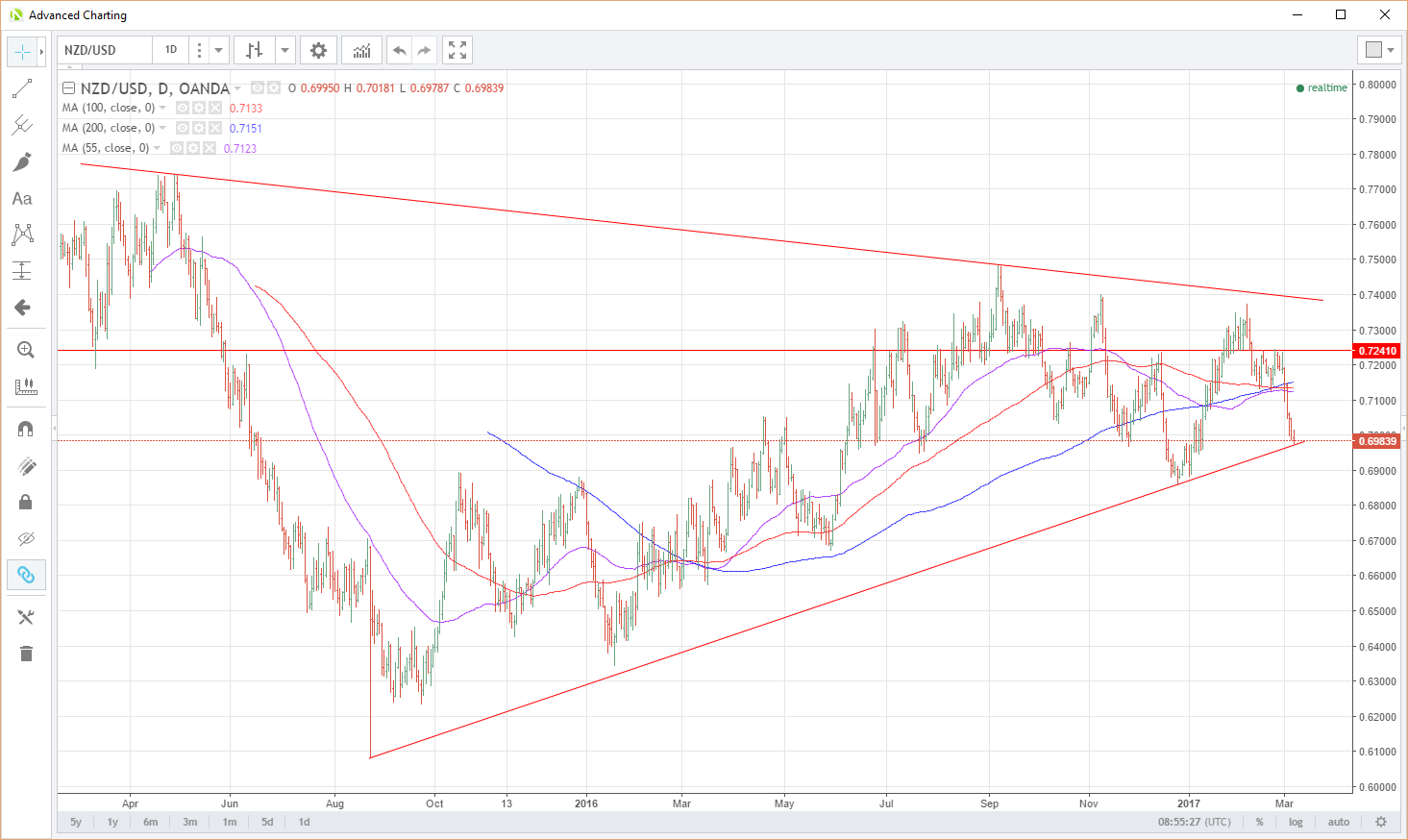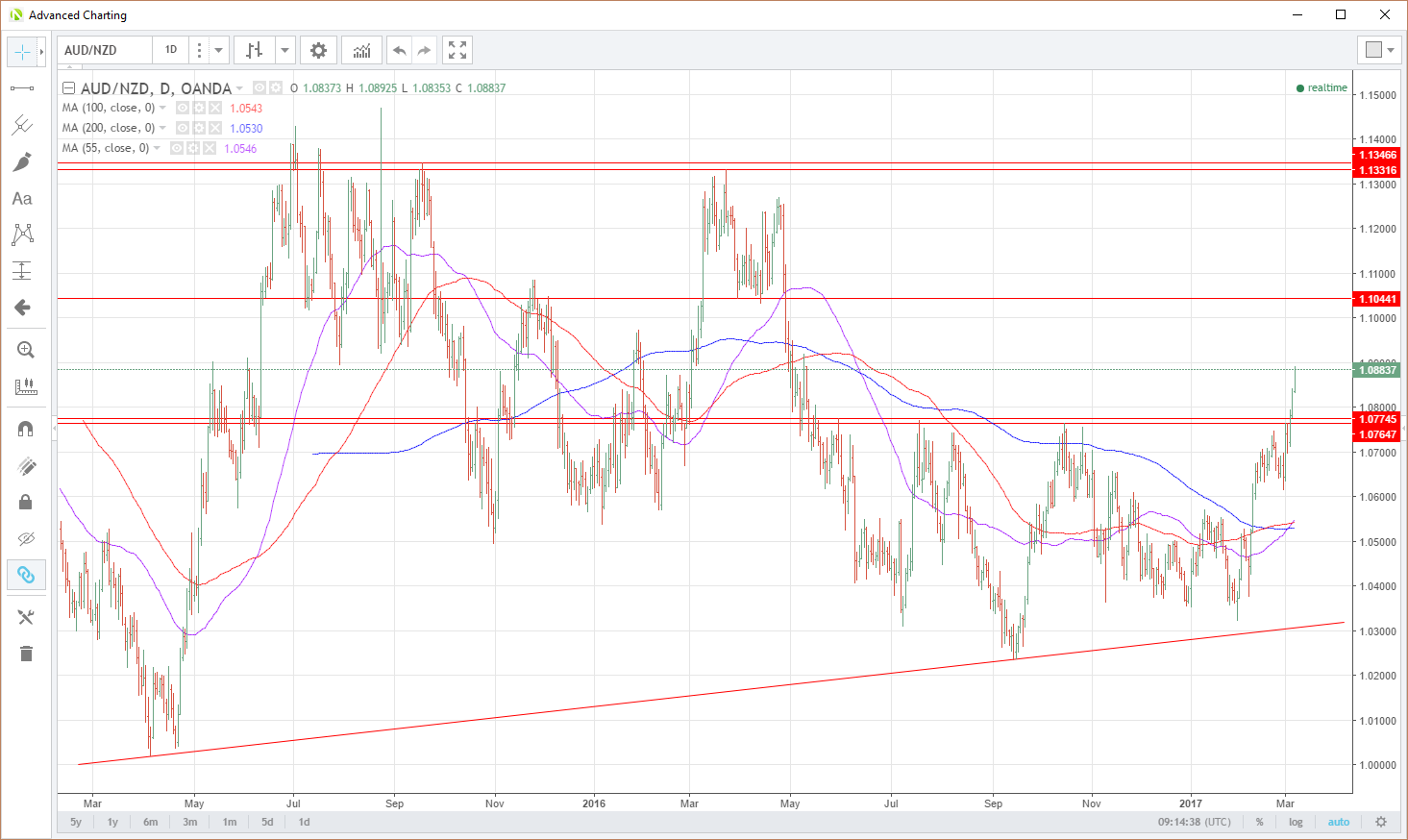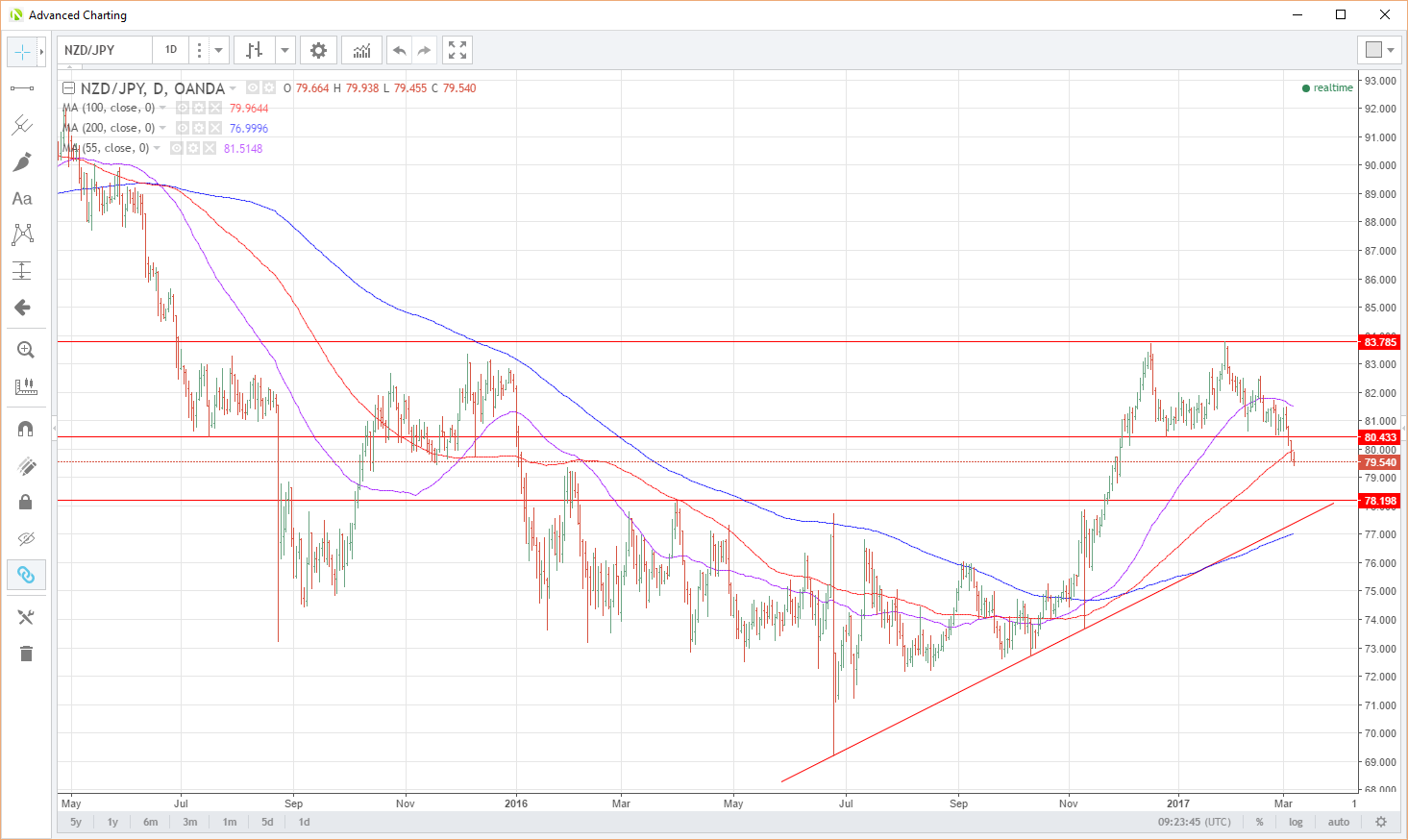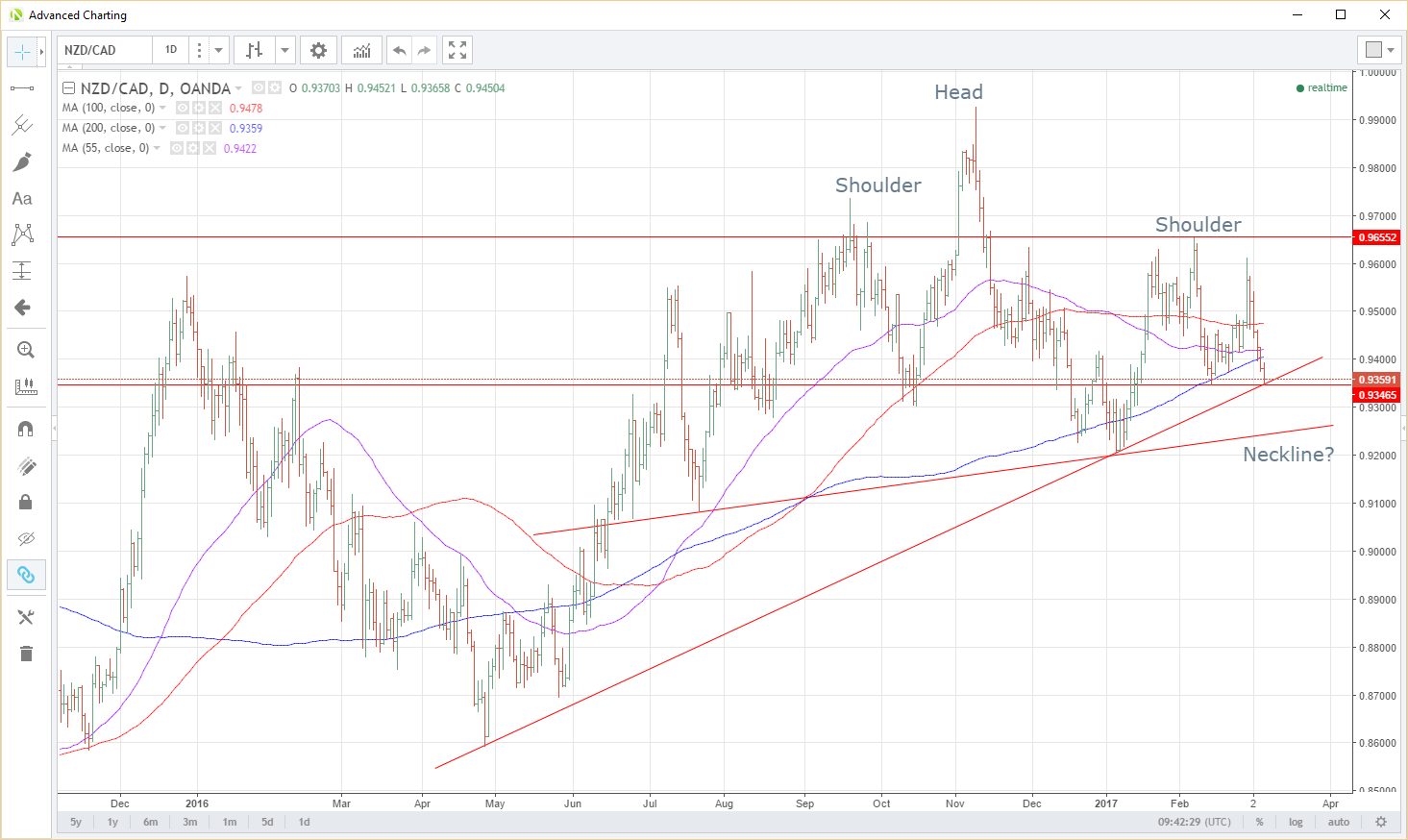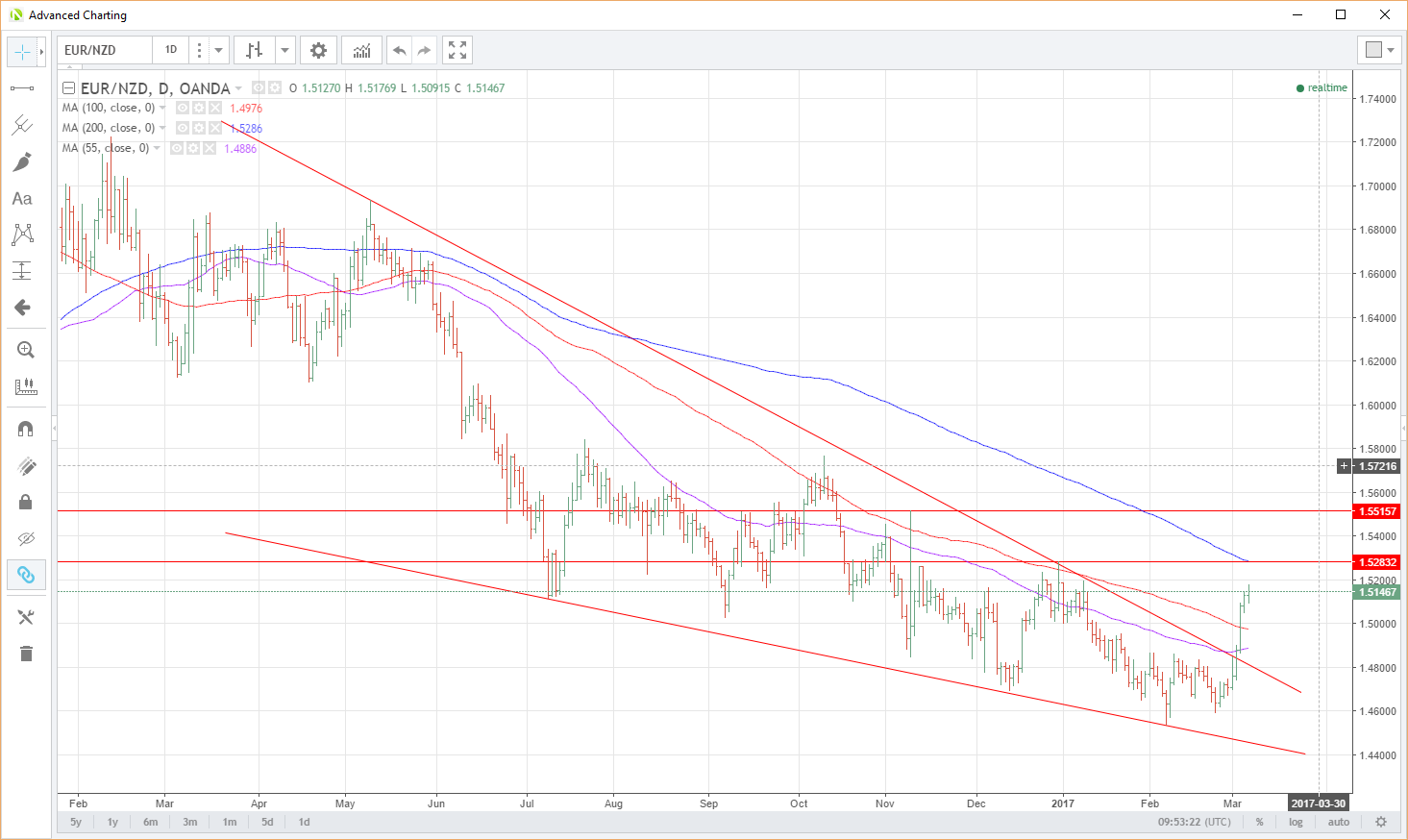The Kiwi has struggled against the USD in recent days, but its travails are showing up on the crosses as well.
The New Zealand is in danger of going from “hero to zero” as we say down under. The Kiwi has given back almost all its Trump-fatigue driven gains of 2017 against not only the USD, but also a number of other currencies via the crosses. There is no one particular reason why everyone’s favourite G-10 yielder seems to have fallen out of favour, rather a combination of factors.
The RBNZ has recently stated that it was comfortable with its current monetary settings and was still not looking at hikes until late 2018 early 2019. This was quite a surprise to many in the domestic market, although my experience there is they are always hawkish on rates anyway. This leads us to the elephant in the room, the U.S. Federal Reserve. Having wrong-footed the market by being universally hawkish into what was supposed to be a non-event March FOMC, precisely the opposite has happened. All we need now is for Friday’s Non-Farm Payroll number to come in around the 190,000 expected and next week should be a done deal. Bond yields have firmed, and a narrowing interest rate differential will undermine the Kiwi although it won’t be alone there in 2017.
Diminishing political risk, most especially in Europe and the glimmer of some actual detail on economic policy by the Trump administration seems to have sapped Kiwi’s haven status. People may laugh at this, but it has merit. If you want to put your money away somewhere far away from the troubles and earn an actual yield on it, you could do a lot worse than New Zealand. My partner and I have just put the Trump hedge on in fact, and bought a small farm down there so consider this facts from the horse’s mouth!
Regarding commodities, New Zealand’s tend to be soft, not hard. Think of it this way, Australia digs gigatonnes of iron ore, copper ore, and coal out of barren patches of red dirt each year and sells it all to the Chinese. New Zealand’s tend to come out of or are made of animals called Daisy, sheep (sheared or chopped up), fish and trees., i.e., soft. The rally in iron ore, copper et al. has dramatically changed Australia’s terms of trade. Meanwhile, dairy prices, in particular, have softened or peaked.
This leads us to tonight’s Global Dairy Auction. (GDT) This is a VERY closely watched number as Dairy is New Zealand’s largest export. The weekly auction since Christmas has all been either flat to -5% in price terms. Tonight it is expected to be somewhere around -10% by the street with optimal growing conditions meaning Daisy the cow is producing a lot of dairy products.
Both the IMF and Moody’s waded in today about household debt and the property market, both saying they present a large negative risk to New Zealand in the event of a “shock.” Finally, the Reserve Bank of New Zealand (RBNZ) stuck the knife in this morning, announcing a bank capital review which may or may not result in the banks being required to raise more capital.
So overall many factors seemed to be conspiring to pluck the Kiwi’s feathers, and this has been reflected in its relative performance on the currency markets.
NZD/USD
Testing an ascending support line that goes back to August 2015 at 6970. The next support being 6866 the December low. Below this, opens 6670 on a technical basis.
Resistance is at 7100 and then 7125/50 containing the 55,100 and 200-day moving averages.(DMA) Behind this, we see a series of daily highs at 7240 and then the long-term descending resistance line at 7390.
AUD/NZD
A less dovish RBA today and higher ore prices, as discussed above, sees the cross move higher again. Some readers will know that I am constantly expounding the dangers of going short AUD/NZD under or near 1.0300 and this chart shows why. From a technical point of view, it always seems to eventually lead to a rally above 1.1000 and many tears from the parity bugs. The cross has come a long way trading at 1.0885 as I write. From a technical point of view, though, it still looks to have legs.
The resistance area at 1.0665/75 has been broken and becomes support and a major pivot level. Below this, we have the 28th Feb low at 1.0618 and then the 1.0525/50 region. This contains the 55,100 and 200 DMA’s. Long term support is at, you guessed it, 1.0300!
Resistance is at the 1.1045 area followed by the 1.1330/45 area.
NZD/JPY
A huge double top is in place at 83.80. NZD/JPY also closed below support at 80.43 and the 100 DMA at 80.00. These three levels all become resistance.
Interim support is at 78.20, followed by the long-term trendline at 77.40 and then the 200 DMA at 77.00.
NZD/CAD
Let’s split this into two parts. I guess the thing to note is that given that Canada has perhaps the world’s most dovish central bank governor at the moment, the Kiwi is sitting just above technical support against the Loonie.
Starting with the obvious, NZD/CAD is hovering just above a long-term ascending support line at 9346. From a technical basis, a daily close below opens a move to the next long-term support line at 9240.
Resistance is at 9400 and 9420, the 55/100 DMA’s, then 9475, the 200 DMA, followed by 9655.
Part 2 is more interesting with what appears to be a head and shoulder formation on the cross. The neckline is the 2nd support at 9240. Measuring the neckline to head gives a distance of 770 points. So technically a break of the neckline could yield a move from 9240 to 8470. Better technicians than I are welcome to discuss.
EUR/NZD
EUR/NZD has been in a descending wedge pattern for the past year, which should be no surprise as we look at the events of 2016. The lines themselves, I confess, are not as exact as I would prefer, but the trend has been clear nevertheless. What is also evident, from a technical perspective, is the breakout from this long-term downtrend in the last few days.
EUR/NZD has broken the top of the wedge at 1.4840, the 55 DMA at 1.4880 and the 100 DMA at 1.4980, these all become support.
The move could imply higher levels yet, with initial resistance at 1.5285, a previous daily high and the 200 DMA. This is followed by another series of daily highs at 1.5515.
Summary
From a technical basis, the Kiwi has broken to the downside against many major currencies. What is interesting is that the price action of the last few days has seen this breakout happen almost simultaneously across the board. Off all the G-10 currencies wizened traders will know that the Kiwi can break hearts (and profits), better than most. Nevertheless, due to the confluence of factors outlined above, the move should be respected. Traders will be closely watching tonight’s Global Dairy Auction to see if the Kiwi gains some respite, or it loses more of its feathers.
Content is for general information purposes only. It is not investment advice or a solution to buy or sell securities. Opinions are the authors; not necessarily that of OANDA Business Information & Services, Inc. or any of its affiliates, subsidiaries, officers or directors. If you would like to reproduce or redistribute any of the content found on MarketPulse, an award winning forex, commodities and global indices analysis and news site service produced by OANDA Business Information & Services, Inc., please access the RSS feed or contact us at info@marketpulse.com. Visit https://www.marketpulse.com/ to find out more about the beat of the global markets. © 2023 OANDA Business Information & Services Inc.


